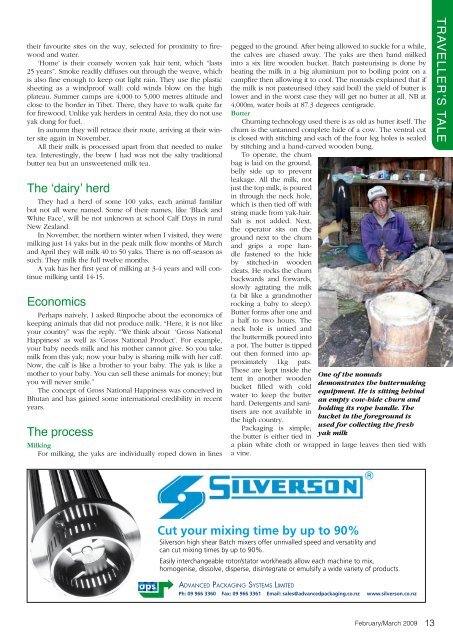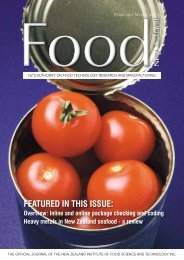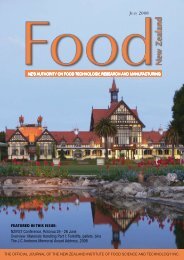featured in this issue - NZIFST - The New Zealand Institute of Food ...
featured in this issue - NZIFST - The New Zealand Institute of Food ...
featured in this issue - NZIFST - The New Zealand Institute of Food ...
Create successful ePaper yourself
Turn your PDF publications into a flip-book with our unique Google optimized e-Paper software.
their favourite sites on the way, selected for proximity to firewood<br />
and water.<br />
‘Home’ is their coarsely woven yak hair tent, which “lasts<br />
25 years”. Smoke readily diffuses out through the weave, which<br />
is also f<strong>in</strong>e enough to keep out light ra<strong>in</strong>. <strong>The</strong>y use the plastic<br />
sheet<strong>in</strong>g as a w<strong>in</strong>dpro<strong>of</strong> wall: cold w<strong>in</strong>ds blow on the high<br />
plateau. Summer camps are 4,000 to 5,000 metres altitude and<br />
close to the border <strong>in</strong> Tibet. <strong>The</strong>re, they have to walk quite far<br />
for firewood. Unlike yak herders <strong>in</strong> central Asia, they do not use<br />
yak dung for fuel.<br />
In autumn they will retrace their route, arriv<strong>in</strong>g at their w<strong>in</strong>ter<br />
site aga<strong>in</strong> <strong>in</strong> November.<br />
All their milk is processed apart from that needed to make<br />
tea. Interest<strong>in</strong>gly, the brew I had was not the salty traditional<br />
butter tea but an unsweetened milk tea.<br />
<strong>The</strong> ‘dairy’ herd<br />
<strong>The</strong>y had a herd <strong>of</strong> some 100 yaks, each animal familiar<br />
but not all were named. Some <strong>of</strong> their names, like ‘Black and<br />
White Face’, will be not unknown at school Calf Days <strong>in</strong> rural<br />
<strong>New</strong> <strong>Zealand</strong>.<br />
In November, the northern w<strong>in</strong>ter when I visited, they were<br />
milk<strong>in</strong>g just 14 yaks but <strong>in</strong> the peak milk flow months <strong>of</strong> March<br />
and April they will milk 40 to 50 yaks. <strong>The</strong>re is no <strong>of</strong>f-season as<br />
such. <strong>The</strong>y milk the full twelve months.<br />
A yak has her first year <strong>of</strong> milk<strong>in</strong>g at 3-4 years and will cont<strong>in</strong>ue<br />
milk<strong>in</strong>g until 14-15.<br />
Economics<br />
Perhaps naively, I asked R<strong>in</strong>poche about the economics <strong>of</strong><br />
keep<strong>in</strong>g animals that did not produce milk. “Here, it is not like<br />
your country” was the reply. “We th<strong>in</strong>k about ‘Gross National<br />
Happ<strong>in</strong>ess’ as well as ‘Gross National Product’. For example,<br />
your baby needs milk and his mother cannot give. So you take<br />
milk from <strong>this</strong> yak; now your baby is shar<strong>in</strong>g milk with her calf.<br />
Now, the calf is like a brother to your baby. <strong>The</strong> yak is like a<br />
mother to your baby. You can sell these animals for money; but<br />
you will never smile.”<br />
<strong>The</strong> concept <strong>of</strong> Gross National Happ<strong>in</strong>ess was conceived <strong>in</strong><br />
Bhutan and has ga<strong>in</strong>ed some <strong>in</strong>ternational credibility <strong>in</strong> recent<br />
years.<br />
<strong>The</strong> process<br />
Milk<strong>in</strong>g<br />
For milk<strong>in</strong>g, the yaks are <strong>in</strong>dividually roped down <strong>in</strong> l<strong>in</strong>es<br />
pegged to the ground. After be<strong>in</strong>g allowed to suckle for a while,<br />
the calves are chased away. <strong>The</strong> yaks are then hand milked<br />
<strong>in</strong>to a six litre wooden bucket. Batch pasteuris<strong>in</strong>g is done by<br />
heat<strong>in</strong>g the milk <strong>in</strong> a big alum<strong>in</strong>ium pot to boil<strong>in</strong>g po<strong>in</strong>t on a<br />
campfire then allow<strong>in</strong>g it to cool. <strong>The</strong> nomads expla<strong>in</strong>ed that if<br />
the milk is not pasteurised (they said boil) the yield <strong>of</strong> butter is<br />
lower and <strong>in</strong> the worst case they will get no butter at all. NB at<br />
4,000m, water boils at 87.3 degrees centigrade.<br />
Butter<br />
Churn<strong>in</strong>g technology used there is as old as butter itself. <strong>The</strong><br />
churn is the untanned complete hide <strong>of</strong> a cow. <strong>The</strong> ventral cut<br />
is closed with stitch<strong>in</strong>g and each <strong>of</strong> the four leg holes is sealed<br />
by stitch<strong>in</strong>g and a hand-carved wooden bung.<br />
To operate, the churn<br />
bag is laid on the ground,<br />
belly side up to prevent<br />
leakage. All the milk, not<br />
just the top milk, is poured<br />
<strong>in</strong> through the neck hole,<br />
which is then tied <strong>of</strong>f with<br />
str<strong>in</strong>g made from yak-hair.<br />
Salt is not added. Next,<br />
the operator sits on the<br />
ground next to the churn<br />
and grips a rope handle<br />
fastened to the hide<br />
by stitched-<strong>in</strong> wooden<br />
cleats. He rocks the churn<br />
backwards and forwards,<br />
slowly agitat<strong>in</strong>g the milk<br />
(a bit like a grandmother<br />
rock<strong>in</strong>g a baby to sleep).<br />
Butter forms after one and<br />
a half to two hours. <strong>The</strong><br />
neck hole is untied and<br />
the buttermilk poured <strong>in</strong>to<br />
a pot. <strong>The</strong> butter is tipped<br />
out then formed <strong>in</strong>to approximately<br />
1kg pats.<br />
<strong>The</strong>se are kept <strong>in</strong>side the<br />
tent <strong>in</strong> another wooden<br />
bucket filled with cold<br />
water to keep the butter<br />
hard. Detergents and sanitisers<br />
are not available <strong>in</strong><br />
the high country.<br />
Packag<strong>in</strong>g is simple;<br />
the butter is either tied <strong>in</strong><br />
One <strong>of</strong> the nomads<br />
demonstrates the buttermak<strong>in</strong>g<br />
equipment. He is sitt<strong>in</strong>g beh<strong>in</strong>d<br />
an empty cow-hide churn and<br />
hold<strong>in</strong>g its rope handle. <strong>The</strong><br />
bucket <strong>in</strong> the foreground is<br />
used for collect<strong>in</strong>g the fresh<br />
yak milk<br />
a pla<strong>in</strong> white cloth or wrapped <strong>in</strong> large leaves then tied with<br />
a v<strong>in</strong>e.<br />
TRAVELLER’S TALE<br />
Cut your mix<strong>in</strong>g time by up to 90%<br />
Silverson high shear Batch mixers <strong>of</strong>fer unrivalled speed and versatility and<br />
can cut mix<strong>in</strong>g times by up to 90%.<br />
Easily <strong>in</strong>terchangeable rotor/stator workheads allow each mach<strong>in</strong>e to mix,<br />
homogenise, dissolve, disperse, dis<strong>in</strong>tegrate or emulsify a wide variety <strong>of</strong> products.<br />
ADVANCED PACKAGING SYSTEMS LIMITED<br />
Ph: 09 966 3360 Fax: 09 966 3361 Email: sales@advancedpackag<strong>in</strong>g.co.nz www.silverson.co.nz<br />
AdvancedPackag<strong>in</strong>g Silverson.<strong>in</strong>dd 1<br />
2/11/06 1:37:34 PM<br />
February/March 2009<br />
13

















